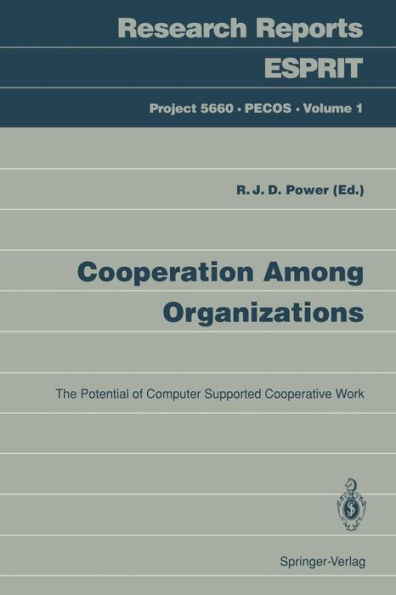Cooperation Among Organizations: The Potential of Computer Supported Cooperative Work
This book reports research conducted in the ESPRIT project PECOS, which investigated the requirements for effective CSCW (Computer Supported Cooperative Work) with special reference to cooperation among organisations in large projects. It indicates commercial areas where CSCW technology can be applied, and examines such methodological issues as enterprise modelling, system architecture, and the incorporation of artificial intelligence techniques. PECOS studied two practical contexts. The first was the management of a complex industrial project, the construction of a high-speed train for the Italian railway, which required cooperation among four private companies. The second was the design of an information system for water management in the Lombardy region, which required cooperation among several different branches of public administration.fhese contexts were analysed, applying techniques of enterprise modelling, in order to identify requirements for CSCW systems. The composition of the book is as follows. Chapter 1 presents some highlights of the vast literature on cooperation, including results from psycholOgy, sociology, management science, linguistics, and artificial intelligence. Chapter 2 reviews the much shorter history of CSCW, with reference to a catalogue of existing systems given in an appendix at the end of the book. The next four chapters contain our original findings.
1111732034
Cooperation Among Organizations: The Potential of Computer Supported Cooperative Work
This book reports research conducted in the ESPRIT project PECOS, which investigated the requirements for effective CSCW (Computer Supported Cooperative Work) with special reference to cooperation among organisations in large projects. It indicates commercial areas where CSCW technology can be applied, and examines such methodological issues as enterprise modelling, system architecture, and the incorporation of artificial intelligence techniques. PECOS studied two practical contexts. The first was the management of a complex industrial project, the construction of a high-speed train for the Italian railway, which required cooperation among four private companies. The second was the design of an information system for water management in the Lombardy region, which required cooperation among several different branches of public administration.fhese contexts were analysed, applying techniques of enterprise modelling, in order to identify requirements for CSCW systems. The composition of the book is as follows. Chapter 1 presents some highlights of the vast literature on cooperation, including results from psycholOgy, sociology, management science, linguistics, and artificial intelligence. Chapter 2 reviews the much shorter history of CSCW, with reference to a catalogue of existing systems given in an appendix at the end of the book. The next four chapters contain our original findings.
54.99
In Stock
5
1

Cooperation Among Organizations: The Potential of Computer Supported Cooperative Work
140
Cooperation Among Organizations: The Potential of Computer Supported Cooperative Work
140Paperback
$54.99
54.99
In Stock

Product Details
| ISBN-13: | 9783540562634 |
|---|---|
| Publisher: | Springer Berlin Heidelberg |
| Publication date: | 03/25/1993 |
| Series: | Research Reports Esprit , #1 |
| Pages: | 140 |
| Product dimensions: | 9.25(w) x 6.10(h) x 0.01(d) |
From the B&N Reads Blog
